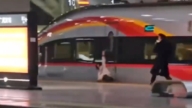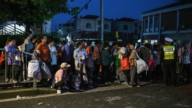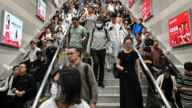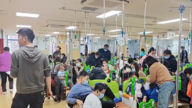【新唐人2014年03月19日訊】日前,中共中央、國務院印發了有關2014年至2020年的《國家新型城鎮化規劃》,並通知各地區部門推進所謂城鎮化的要求和目標。而專家表示,中國地方政府不斷圈地,把民眾的土地給剝奪了,這些失地農民卻進不了城,也回不了鄉,處境悲慘。另有專家認為,中國的城鎮化發展需要轉型,農業轉移人口落戶城鎮,不只是一紙戶口變更那麼簡單,保障對接還存在體制機制上的障礙。
中國自1990年代以來,隨著工業化、城鎮化的加快,大量農村土地被徵收、佔用、開發,不僅影響農村發展,而且威脅糧食安全,同時,失地農民還面臨「種地無田、就業無崗、低保無分」的困境。
中共當局日前提出《新型城鎮化規劃》,計劃從今年到2020年的6年期間,將「常住人口城鎮化率達到60%左右,戶籍人口城鎮化率達到45%左右,戶籍人口城鎮化率與常住人口城鎮化率差距縮小2百分點左右。」而且還要「努力實現1億左右農業轉移人口和其他常住人口在城鎮落戶」等。
大陸金融分析師任中道﹕「中共政府的戶籍政策,在上世紀50年代,強制的分成農村人口和城市人口。剛開始的時候,農村人只能生活在農村,至於城市的居民的福利待遇,相差很多。日前中共開始新型的城鎮化的這樣的規劃,說是要6年內解決1億人進城,那麼,首先得保證現在民眾的相關的福利待遇,醫療、教育、養老等等。」
目前中國農民的失地問題,表現在三個方面,一是﹕土地農轉非速度太快,土地徵佔規模過大,失地農民群體越來越多﹔二是﹕對失地農民補償太低,不足以解決他們的長遠生計﹔三是﹕失地農民的社會保障、及再就業困難。
當前中國的城市退休人員的平均養老金,是新農保的30多倍,顯然,較低的新農保養老金,難以滿足老年人的基本生活需求。
而中國的城鎮化率,近年來每年增長1.3%,每年相應增加的城鎮人口約有1800萬人,但每年新增就業崗位不到1200萬個。
山東臨沂農民工盧女士﹕「我覺得大部分老百姓不積極想進城,因為那個進城成本他們都感覺到太高了,當然他們負擔不起。你年輕的還可以,年輕人像進工廠、去打工、作工,但是年紀大的人比較悲慘,因為他們的土地也沒了,他有土地的話,他最起碼能種出糧食來。」
大陸《21世紀網》報導,農業人口轉移落戶城鎮的人均公共成本,以安徽省為例,在10萬元左右﹔個人成本不含購房成本,超過1萬5000元。而安徽省城、鄉居民的「社保」差距,在5:1以上。
任中道﹕「到現在為止,中共完成的只是偽城鎮化。即便把土地徵用了、開發了、建設了,但是相應的那些人,他處在一個夾心層的狀態。甚麼叫夾心層啊﹖有很多農村的人,4、50歲了,所受的教育、他社會的經驗,甚至體力都無法在城市工作,他就是留不在城,回不了鄉,留在城裡他可能沒辦法養老,他的醫療、各種保障都沒有,也沒有自己的住所。」
有專家提出,中國的城鎮化發展需要轉型。大陸中科院院士陸大道向《21世紀網》表示,城鎮就業是決定城鎮化速度、城鎮規模的主要支撐條件。近年來,中國城鎮化速度較快,產業支撐無法跟上,城鎮就業崗位的增加趕不上城鎮新增人口的增長。
任中道﹕「現在大家也都看到了,現在中國的經濟情況不怎麼好,因此,這麼多人進城,他的工作經驗,包括福利保障等等,它(中共)如果不解決的話,它的城鎮化實際上只是紙上談兵。」
盧女士﹕「它(中共)不怕這1億多農民變成城市的人的話,其實按照中國的現狀,就是耕地被大量的佔用,就是因為這個土地越來越少,老百姓沒有地可種,沒辦法,才把這些人變成城市的人。」
當前,中國大陸因徵地問題引發的群眾抗爭越來越烈,而如何讓那些處在夾心層的失地農民安度晚年,同樣也令人擔心。
採訪/陳漢 編輯/周平 後製/李勇
The New Urbanization Plan: Where Is Social Security For Farmers?
Recently, the CCP Central Committee and the State Council
issued the new national urbanization plan, 2014 through 2020.
Local authorities have been notified that they are to promote
the so-called urbanization requirements and objectives.
Experts say the local governments have deprived people
of land.
This movement leads landless farmers into a tragic situation
—they can neither enter the city, nor return to the farm.
Other experts believe that China’s urbanization development
needs restructuration, as transferring farmers into cities
is not as easy as transferring a household registration.
There are institutional barriers for protecting
the farmers’ social security.
With the acceleration of industrialization and urbanization
in China since the 1990s, a large amount of rural land
was occupied for economic development,
which threatens rural development and food security.
At the same time, the landless farmers also face difficulties,
such as no land, no employment and no social insurance.
According to the new urbanization plan, the resident
population urbanization rate will reach 60 percent,
the household population urbanization rate will reach
roughly 45 percent, and the gap between the household
urbanization rate and the population urbanization rate
will reduce by 2 percent.
All these targets will be accomplished
in the following 6 years.
Besides, about 100 million farmers will be settled
in the town.
Financial Analyst Ren Zhongdao (China): “According
to the CCP household registration policy in the 1950s,
the Chinese people have been forced to divide into
two groups—the rural population and urban population.
At the beginning, the rural people are required
to live in the rural areas.
As for the benefits, there are a lot of differences
with the residents in the city.
The new urbanization plan calls for settling
100 million farmers in the town.
First of all, the authorities have to ensure welfare for
rural dwellers, including medical, education, pension, etc."
At present, the landless issues lead to three problems: first,
the land transfer speed is too fast and the land requisition
is too big –there are more and more groups of landless farmers;
Second, the compensation for the landless farmers
is too low, not enough to solve their long-term livelihood.
The third is the social security and re-employment
issues for the landless farmers.
According to the new urbanization plan, the current average
pension of urban retirees is 30 times more than that of rural retirees.
Obviously, it is difficult to meet the basic needs
of the elderly living in rural areas.
The urbanization rate in China increased by 1.3 percent
per year recently.
The corresponding increase in the urban population
is about 18 million per year, but the annual increase
of jobs is less than 12 million.
Ms. Lu, a migrant worker in Linyi, Shandong: “I think
most people do not want to settle in the city due
to the high living cost.
Of course they cannot afford it.
It could be okay for young people as they could find jobs
in the factory.
But for the older people, it is miserable –
their land is missing.
With the land, they could grow food at least."
The 21st Century Network reported that the per capita
public costs for transferring the rural population
into the town is about 100,000 yuan in Anhui province.
The personal cost (excluding housing) is more than
15,000 yuan.
The social security gap between rural retirees and urban
retirees is more than 5:1 in the capital of Anhui rural.
Ren Zhongdao: “Until now, what the CCP completed
is just a pseudo-urbanization.
Even the expropriated land was used for economic
development, but those related people are moved
into a sandwich layer.
What does ‘sandwich layer’ mean?
For many 40 to 50 year-old people living in rural areas,
they cannot work in the city according to their
educational or social status and even their
health condition.
They can’t live in the city, nor return to the rural areas.
There is no medical insurance, pension or other
social security, including housing."
Some experts suggest that China’s urbanization
development needs restructuration.
Lu Dadao, the academician of Chinese Academy
of science told the 21st Century Network that
urban employment can determine the speed
of urbanization.
It is the primary condition for sustainment
of the urban-scale.
In recent years, China’s urbanization rate is too fast.
However, the industry support cannot keep up,
so as to the jobs increase rate in urban areas.
Ren Zhongdao: “Now we find that China’s
economic situation is not very good.
Therefore, if the social security for the farmers cannot
be solved, then the urbanization will only be talk."
Ms. Lu: “The CCP is not afraid of transferring these more
than 100 million farmers into the city.
According to China’s current situation, a lot of arable lands
have been occupied.
The land is less and less – there is no land for people
to cultivate.
Therefore, the CCP has to transfer these people into
the cities."
Currently, the struggle caused by land acquisition problems
is increasing.
Those in the sandwich layer –the landless farmers—deserve
to be shown concern.
Interview/Chen Han Edit/Zhou Ping Post-Production/Li Yong






























